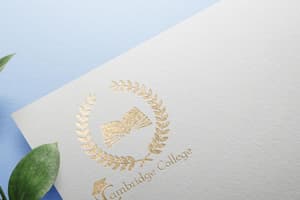Podcast
Questions and Answers
What is the primary function of auxiliary verbs?
What is the primary function of auxiliary verbs?
- To serve solely as the subject of a sentence
- To modify adjectives
- To replace main verbs in sentences
- To assist in the formation of various verb tenses (correct)
Auxiliary verbs are only used to form questions.
Auxiliary verbs are only used to form questions.
False (B)
Give an example of a modal auxiliary verb that indicates obligation.
Give an example of a modal auxiliary verb that indicates obligation.
must
Auxiliary verbs are crucial for forming ________.
Auxiliary verbs are crucial for forming ________.
The primary auxiliary verbs include ________, ________, and ________.
The primary auxiliary verbs include ________, ________, and ________.
Which auxiliary verb would you use to form a negation in the sentence 'I _____ like spinach'?
Which auxiliary verb would you use to form a negation in the sentence 'I _____ like spinach'?
Match the following auxiliary verbs with their primary usage:
Match the following auxiliary verbs with their primary usage:
'Could' is a modal auxiliary verb used to suggest a lesser degree of possibility.
'Could' is a modal auxiliary verb used to suggest a lesser degree of possibility.
The structure for past perfect tense is 'had' + ________.
The structure for past perfect tense is 'had' + ________.
What is the auxiliary verb used to form a question in the present simple?
What is the auxiliary verb used to form a question in the present simple?
Flashcards are hidden until you start studying
Study Notes
Functions of Auxiliary Verbs
- Formation of Tenses: Help create various verb tenses (e.g., "is running" for present continuous).
- Formation of Questions: Assist in forming interrogative sentences (e.g., "Are you coming?").
- Negation: Used to create negative forms of verbs (e.g., "do not go" or "is not coming").
- Voice: Aid in forming passive voice constructions (e.g., "The book was read by her").
- Mood: Contribute to indicating modality (e.g., "could" for ability or "should" for obligation).
Types of Auxiliary Verbs
-
Primary Auxiliary Verbs:
- Be: Used for continuous tenses and passive voice.
- Have: Used for perfect tenses.
- Do: Used for negation, questions, and emphatic forms.
-
Modal Auxiliary Verbs:
- Express necessity, possibility, ability, permission, or obligation.
- Examples include:
- Can: Ability or possibility.
- Could: Past ability or polite requests.
- May: Permission or possibility.
- Might: Suggests a lesser degree of possibility.
- Must: Obligation or necessity.
- Shall: Future intention (more common in British English).
- Should: Recommendation or obligation.
- Will: Future actions or willingness.
- Would: Polite requests or hypothetical situations.
Fill the Blank
- Auxiliary verbs are crucial for forming ________.
- The primary auxiliary verbs include ________, ________, and ________.
- Modal auxiliary verbs express ________, ________, and ________.
- The structure for past perfect tense is "had" + ________.
- To form a question in the present simple, use the auxiliary verb ________.
- "The cake was baked by the chef" is an example of the ________ voice.
Functions of Auxiliary Verbs
- Auxiliary verbs are crucial for forming various verb tenses, questions, negation, voice, and mood.
- Auxiliary verbs help you conjugate a verb into different tenses.
- They allow you to create question forms.
- They are used to create negative forms of verbs.
- Auxiliary verbs support verbs in passive voice constructions.
- They express modality, which includes concepts like ability, obligation, and possibility.
Types of Auxiliary Verbs
- Primary auxiliary verbs include be, have, and do.
- Be is used for continuous tenses (e.g., is running) and passive voice (e.g., was eaten).
- Have is used for perfect tenses (e.g., have eaten).
- Do is used for negation (e.g., did not eat), questions (e.g., did you eat), and emphatic forms (e.g., do eat).
- Modal auxiliary verbs express necessity, possibility, ability, permission, or obligation.
- Modal auxiliary verbs include can, could, may, might, must, shall, should, will, and would.
- Can implies ability or possibility.
- Could indicates past ability or polite requests.
- May refers to permission or possibility.
- Might suggests a lesser degree of possibility.
- Must signifies obligation or necessity.
- Shall expresses future intention (more common in British English).
- Should implies recommendation or obligation.
- Will denotes future actions or willingness.
- Would indicates polite requests or hypothetical situations.
Fill the Blank
- Auxiliary verbs are crucial for forming **various verb tenses, questions, negation, voice, and mood **.
- The primary auxiliary verbs include be, have, and do.
- Modal auxiliary verbs express necessity, possibility, ability, permission, or obligation.
- The structure for the past perfect tense is "had" + past participle.
- To form a question in the present simple, use the auxiliary verb do.
- "The cake was baked by the chef" is an example of the passive voice.
Studying That Suits You
Use AI to generate personalized quizzes and flashcards to suit your learning preferences.




